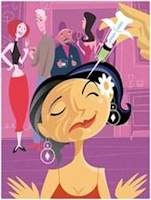Botulinum toxin
What is botulinum toxin and how does it work?
It is a substance produced by the bacterium clostridium botulinum, purified and extracted under controlled conditions.



 Botulinum toxin is authorized on the French pharmaceutical market (Vistabel ® in France, and Botox ® in the United States) for a well-defined use. It must only be used judiciously, under strict medical supervision and by a trained physician.
Botulinum toxin is authorized on the French pharmaceutical market (Vistabel ® in France, and Botox ® in the United States) for a well-defined use. It must only be used judiciously, under strict medical supervision and by a trained physician.
It had already been used by ophthalmologists, neurologists and ENT specialists to correct certain disorders (strabismus or abnormal movements), before being officially authorized in France on/02/2003 for aesthetic purposes in specific indications.
Use is reserved exclusively for specialists in plastic, reconstructive and aesthetic surgery, dermatology, face and neck surgery, maxillofacial surgery and ophthalmology.
Several types of toxins are available in France
Botox® Vistabel® Allergan 100 U
Dysport® Ipsen (Reloxin® awaiting MA) 500 U
Xeomin ® toxin type A
BotoxinA® Mobilab PM 50 and 100 U
topical and injectable form
Neurobloc ® toxin type b 5000 U
By relaxing the muscles in a given area, botulinum toxin limits muscle contraction, temporarily erasing expression lines and giving a more relaxed, serene and rested appearance.
Is botulinum toxin dangerous?
The bacterium clostridium botulinum produces a toxin which, if absorbed in large quantities, can cause botulism, a rare form of food poisoning. It requires doses at least a thousand times higher than those used for treatment. By comparison, aspirin, although considered a safe drug, can prove fatal if ingested in doses ten times higher than those recommended. Botulinum toxin therefore has a much wider safety margin than most drugs.
What are the applications?
Not only in the treatment of wrinkles, but also in the treatment of facial asymmetries, notably post-paralytic, i.e. after facial paralysis, post-traumatic, in hypersalivation, muscle spasms or hypersudation, or the after-effects of certain treatments such as cervical radiotherapy.
In facial paralysis, the toxin enables symmetrization of the face, especially in the upper part.
For aesthetic indications, certain movements at the top of the face, such as frowning, blinking and wrinkling the nose, strengthen the muscles they call upon and are at the origin of expression lines. Crow's feet, forehead wrinkles and wrinkles between the 2 eyebrows fall into this category. Botulinum toxin attacks the source of the problem, by relaxing the muscles, and so while rejuvenating the face, it gives a more relaxed, serene and rested appearance.
SEQUENCE OF INJECTIONS :
You do not need to fast on the day of the injections. You should not take aspirin, anti-inflammatories or vitamin C for 7 days before or 7 days after the injections. For women, plan to come without make-up or to remove it before the injections.
The procedure itself takes around 15 minutes. The doctor injects small quantities of the product into the muscle. The injections, which cause little or no pain, give a "forehead lift" appearance, avoiding the need for surgery under anaesthetic.
For 4 hours after the injections, we recommend that you refrain from strenuous exercise or lying down. You should also avoid manipulations (massaging the treated areas) for 24 hours after the session. However, you can continue most of your normal daily activities. Contract the treated muscles for 2-3 hours after treatment (frowning, looking up, for example), to promote intramuscular fixation of the product.
Injections leave no marks on the face. There may be some redness at the injection sites, but this disappears within an hour, and make-up can be applied.
The beneficial effect on the severity of wrinkles, although perceptible 72 hours after treatment, reaches its peak 10 to 15 days later.
EFFECTS AND FREQUENCY OF INJECTIONS :
Results will be visible within a few days, but for a fortnight or so, the effects on the face may be variable (even asymmetrical at times), before finally stabilizing. At the time of the first session, after 4 to 6 months, the effects will normally have disappeared. Results last longer with repeated injections. Injections should be performed 2 to 3 times, 5 to 8 months apart, to achieve a certain stability of results.
It is recommended that injections should never be given less than 4 months apart, to avoid creating resistance to the products ("vaccine effect" through the production of anti-toxin antibodies).
In the case of thick skin or a "deep break", it may be necessary to perform other techniques (filling) to optimize the result.
A consultation is recommended between 8 and 15 days after the injections to assess the result.
If you wear contact lenses, you may need to put a few drops of artificial tears in each eye for a few days (injections can sometimes reduce tear secretion).
Information on the potential risks of botulinum toxin:
ARE THERE ANY RISKS OR CONTRAINDICATIONS TO BOTULINUM TOXIN?
ADVERSE EVENTS MAY OCCUR
Common : One in five patients will experience transient side effects (headache, bruising, facial pain, slight eyelid weakness, sensation of forehead tension) related to product release.
Exceptional cases: If the product reaches the eyelid levator, the patient's eyelid may droop (ptosis). If the motor muscles of the eyes are affected, visual disturbances may occur (strabismus, dry eyes, tearing, etc.). These accidents, which are reversible within a few weeks, are extremely rare if the injection technique is rigorous and performed by well-trained doctors.
No cases of systemic toxicity (by diffusion in the body) resulting from an injection have been recorded, as doses would have to be a thousand times higher than those used for treatment.
WHAT ARE THE CONTRAINDICATIONS TO BOTULINUM TOXIN INJECTIONS?
The product is not suitable for pregnant or breastfeeding women, people with neurological diseases such as myasthenia gravis, or patients taking anticoagulants or suffering from coagulation disorders.
This treatment is not recommended for people under 18.
As a general rule, if you are being treated with Botulinum Toxin injections for pathological spasms, if you have had an episode of facial muscle paralysis, if you or a member of your family suffer from a neuromuscular disease such as myasthenia gravis, or from a coagulation disorder, you should inform Doctor Xavier LACHIVER. Together with your attending physician, he will decide whether injections are appropriate for you, and if so, how best to proceed.
INADVISABLE COMBINATIONS
Aminoside antibiotics, because of the risk of increasing the effects of botulinum toxin, by extrapolation from the effects observed in botulism. If necessary, use another antibiotic.
No other clinically significant interactions have been reported.
If you are taking anticoagulants, aspirin or any other medication (e.g. aminosides, tetracyclines, quinine, penicillamine, calcium channel blockers, benzodiazepines, muscle relaxants) before the injections, or if you have any health problems (e.g. infection, flu, dental abscess, allergy to egg or albumin, etc.), you must inform the doctor before the injection.
If you are pregnant, even by just a few days, it is imperative to postpone the date of injections until after pregnancy and breast-feeding. If you have any doubts, you should carry out the necessary tests and inform your doctor of the results.
IN CONCLUSION
In modern society, botulinum toxin treatment makes it possible to offer others a face with a rested, relaxed appearance, whatever the circumstances.
It's an investment in the preservation of youth capital with maximum security and maximum results.

